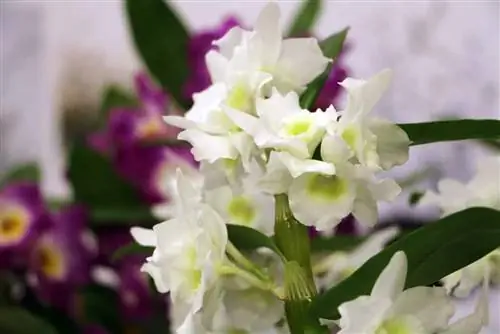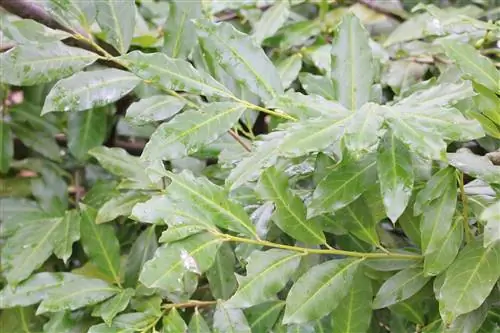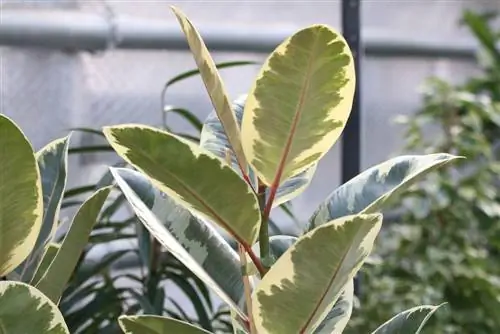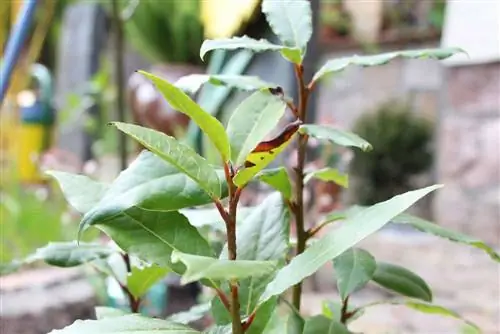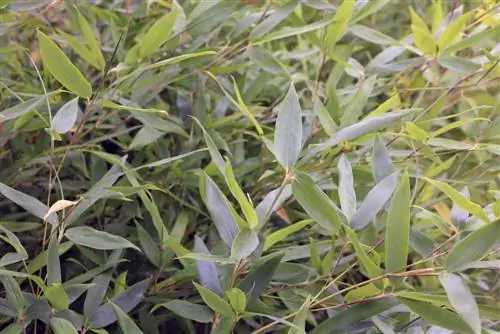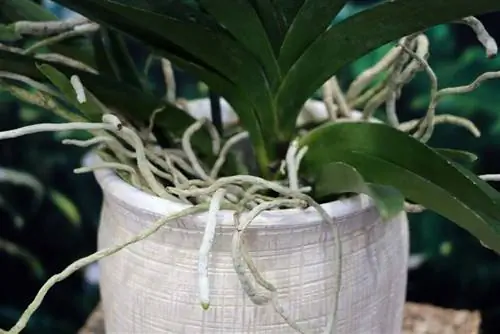- Author admin [email protected].
- Public 2023-12-17 03:39.
- Last modified 2025-01-24 12:45.
An orchid is primarily enchanting with its long-lasting, delicate flowers. But if the leaves of the plant hang limply or even begin to wilt, the entire appearance is disturbed. The orchid will not recover on its own. Courageous intervention is necessary so that she can recover quickly. The causes of wilted leaves can be varied, but there are also solutions.
malicious image
He althy orchid leaves feel smooth and plump, the green is strong in tone. On the other hand, leaves that hang limply and weakly look damaged and diseased. The surface of these leaves can also have folds and wrinkles and the green color loses its luminosity. the leaves turn yellow at the edges. These are all clear signs that the plant is either sick or there is something fundamentally wrong with the care.
Tip:
When buying a new orchid, always pay attention to the appearance of the leaves. They must be plump and bright green. Otherwise, it's best to leave it alone.
Important Notice
First of all: Do not cut off the withered leaves! On the one hand, there is a chance that you can get them fit again. On the other hand, pathogens can penetrate through the open interfaces and cause even more damage to the already weakened orchid. First, investigate possible causes and take appropriate action. The wilted leaves will either recover over time, or they will eventually dry up completely and can be easily removed by hand.
Possible causes
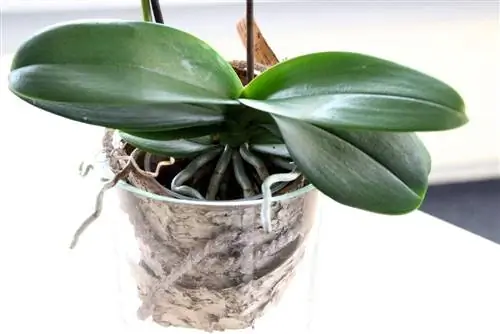
The possible causes are numerous and the actual cause is not always immediately obvious. Sleeping leaves could quickly be interpreted as a lack of water and people reach for the watering can. Don't be too hasty! Perhaps too much water has damaged the roots and made it more difficult for them to absorb water. It is therefore best to take a close look at all possible causes in order to determine without a doubt the actual trigger for wilting leaves. Sometimes a combination of several causes is to blame for the wilted leaves. The possible causes are:
- Lack of water due to too little watering
- Root rot due to waterlogging
- Lack of light at current location
- high temperature fluctuations
- normal aging process
- Diseases
- Pests
Water shortage
If the orchid gets too little water, its vitality suffers. Wilted flowers and floppy leaves are the first signs of this. Even buds that have not yet bloomed can fall off prematurely. The substrate of an orchid should never dry out completely. The orchid must be watered as soon as the substrate has significantly lost moisture, but there is still some residual moisture. White or light green roots are a sign of dryness.
Take the following emergency measures immediately:
- Immediately immerse the pot in the water for a few minutes.
- Wait until the substrate is saturated.
- Make sure that no water gets on the leaves.
- Place the plant back on the saucer or in the planter.
- After a few minutes, check whether water has collected in the saucer.
- Pour away excess water from the saucer.
Don't be disappointed if this dive doesn't bring any change to the wilted leaves. It is very likely that the new leaves will sprout he althy and strong. In the future, treat the orchid to a new dive every time the substrate has noticeably lost moisture. This is the best watering method.
Tip:
If you hold the orchid by the stem and lift it slightly, you will soon get a feel for when it is time to water based on its weight. A freshly watered orchid feels much heavier than one that needs water again.
Waterlogging
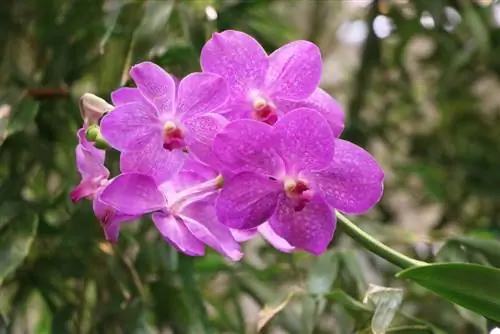
If the orchid is watered too often and too much, water can collect in the saucer. The orchid reacts quickly to prolonged wetness with root rot. Rotting roots cause their water absorption to be permanently disrupted, while at the same time the leaves lose moisture through evaporation. If the root rot is very advanced, the orchid can no longer be saved. If only the leaves are wilted and soft, but the shoots are still strong, there is hope that it will survive.
- Take the plant out of the pot immediately.
- Gently shake off the substrate.
- Take a close look at the roots: He althy roots are firm and green. Rotting ones are muddy and brown.
- Using a sharp and clean knife, cut off any rotting roots.
- Remove all flower shoots, the orchid must concentrate its energy on root formation.
- Rinse the root ball carefully under running water
- Let the plant dry well.
- Plant the plant in new substrate.
- Spray the aerial roots of the orchid regularly until new roots have grown in the pot.
Tip:
As a precaution, wear gloves during this rescue operation, some species of orchids are partially poisonous. Adding algae extracts to irrigation water can accelerate root formation.
Watere less in the future and only when the substrate has significantly lost moisture.
Lack of light
Is your orchid in a dark place? If so, lack of light can cause the orchid to drop all of its leaves overnight. Immediately place the orchid in a bright location, but without direct sunlight. Other large plants that are in the immediate vicinity of the orchid can also take away the light from the smaller orchid. Free the orchid covered in this way from the shade.
High temperature fluctuations
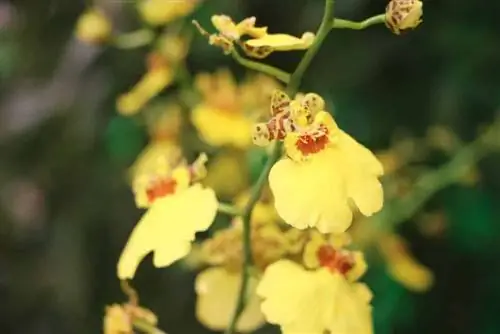
Orchids are sensitive to temperature fluctuations. In winter you are not allowed to stand in unheated rooms. Rooms that have different temperatures throughout the day are also not suitable for orchids. In summer, direct sunlight is harmful to you. In this case, find a new location for your orchid. A window that faces north, west or east is a good idea. Overwinter your orchid in a room that is evenly warm, but not right next to the heater. Cold drafts when ventilating are also harmful.
Normal aging process
If the leaves turn yellow and fall off, there is not always cause for concern. The normal aging process also means that a leaf dies every now and then. As a rule, it is the lowest leaf that dies first due to age. As long as not many leaves turn yellow at the same time and as long as new leaves sprout, everything is fine.
Especially in autumn and winter, when the orchid needs some rest in its vegetation, individual leaves can dry out and fall off.
Diseases
If many leaves turn yellow, stem rot is very likely. Bacteria have gotten onto the plant through the irrigation water and are causing it to rot right at the base. If water gets into the leaf axils when watering, the disease is further encouraged. Unfortunately, any help comes too late for the affected orchid. It now belongs in the trash. Stem rot can be prevented with proper care. An important insight if you have additional orchids or want to buy a new orchid.
Prevention is the only solution here. The smut disease causes black spots on the leaves, which soon afterwards also turn yellow and wilt. The plant can usually no longer be saved.
Pests
Check your orchid for pests, such as scale insects. These like to hide on the underside of the leaves and near the roots. The pests suck the liquid out of the leaves. Since they multiply very quickly, the orchid is weakened quickly. Treat the orchid promptly with a suitable product.
The thrips pest, which looks like a small fly, can be controlled with a pesticide.
Alternatively, the pests can be picked up by hand or drowned in water, which involves submerging the entire plant in water for about 30 minutes.
Note:
Pests can quickly spread to neighboring plants, so check them for pest infestation too. Isolate all infected plants from he althy ones to minimize the risk of infection.
Strengthening the plant
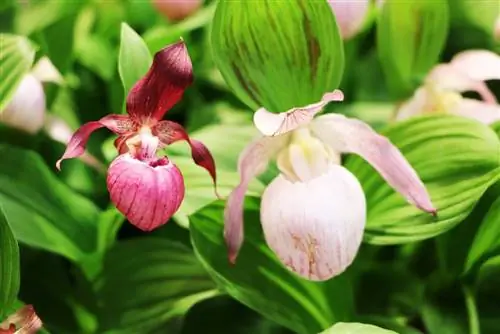
After an illness or weakening due to care errors, the orchid needs to be strengthened again. There are some products available commercially that strengthen the leaves and support flower formation. This means your orchid will regain its lost vitality more quickly and become more resilient.
Prevention
Prevention is still the best method to prevent wilted leaves on orchids. If the rescue measures for one orchid may come too late, there is still time to protect other orchid specimens from wilting leaves through better care and a more suitable location. According to the motto “We learn from harm”.

